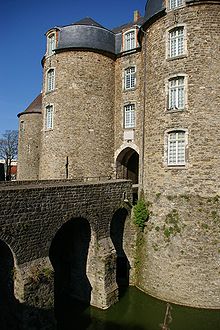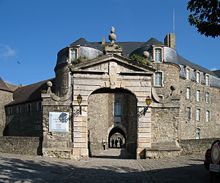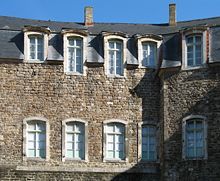
Château de Boulogne-sur-Mer
Encyclopedia



Castle
A castle is a type of fortified structure built in Europe and the Middle East during the Middle Ages by European nobility. Scholars debate the scope of the word castle, but usually consider it to be the private fortified residence of a lord or noble...
in the French seaport of Boulogne-sur-Mer
Boulogne-sur-Mer
-Road:* Metropolitan bus services are operated by the TCRB* Coach services to Calais and Dunkerque* A16 motorway-Rail:* The main railway station is Gare de Boulogne-Ville and located in the south of the city....
, in the Pas-de-Calais département
Départements of France
The departments of France are French administrative divisions. The 101 departments form one of the three levels of local government, together with the 22 metropolitan and 5 overseas regions above them and more than 36 000 communes beneath them...
. It houses the Boulogne museum.
The castle was built in the 13th century by Philippe Hurepel
Philippe Hurepel
Philip Hurepel was Count of Clermont-en-Beauvaisis, Boulogne, Mortain, Aumale, and Dammartin. He was the son of Philip II of France and his controversial third wife Agnes of Merania. Illegitimacy shadowed his birth and career....
(1180-1234), count of Boulogne and son of Philip II of France
Philip II of France
Philip II Augustus was the King of France from 1180 until his death. A member of the House of Capet, Philip Augustus was born at Gonesse in the Val-d'Oise, the son of Louis VII and his third wife, Adela of Champagne...
. Following the death of his half-brother, king Louis VIII
Louis VIII of France
Louis VIII the Lion reigned as King of France from 1223 to 1226. He was a member of the House of Capet. Louis VIII was born in Paris, France, the son of Philip II Augustus and Isabelle of Hainaut. He was also Count of Artois, inheriting the county from his mother, from 1190–1226...
after a short three-year reign, Hurepel was one of the leaders of a rebellion against the regent, Blanche de Castille, mother of the minor Louis IX
Louis IX of France
Louis IX , commonly Saint Louis, was King of France from 1226 until his death. He was also styled Louis II, Count of Artois from 1226 to 1237. Born at Poissy, near Paris, he was an eighth-generation descendant of Hugh Capet, and thus a member of the House of Capet, and the son of Louis VIII and...
. He constructed castles at Calais
Calais
Calais is a town in Northern France in the department of Pas-de-Calais, of which it is a sub-prefecture. Although Calais is by far the largest city in Pas-de-Calais, the department's capital is its third-largest city of Arras....
and Hardelot and refortified Boulogne. The castle is built in the eastern corner of the medieval walls surrounding the Haute Ville (literally, high town - the part of Bologne on the hill). The walls themselves were reconstructed by Hurepel. The eastern part of the castle was built over a corner of the Roman
Ancient Rome
Ancient Rome was a thriving civilization that grew on the Italian Peninsula as early as the 8th century BC. Located along the Mediterranean Sea and centered on the city of Rome, it expanded to one of the largest empires in the ancient world....
wall, parts of which are still visible in the basement. Housing together the political, legal and economic powers of the time, it was also a residential and defensive site.
Various modifications have taken place. Major alterations were carried out by the duc de Berry
John, Duke of Berry
John of Valois or John the Magnificent was Duke of Berry and Auvergne and Count of Poitiers and Montpensier. He was the third son of King John II of France and Bonne of Luxemburg; his brothers were King Charles V of France, Duke Louis I of Anjou and Duke Philip the Bold of Burgundy...
between 1394 et 1416. The horse shoe shape (barracks, arsenal) was completed around 1567. After being adapted because of developments in artillery during the 16th century, it lost some of its medieval character. In 1767, it became a barracks and, after World War II
World War II
World War II, or the Second World War , was a global conflict lasting from 1939 to 1945, involving most of the world's nations—including all of the great powers—eventually forming two opposing military alliances: the Allies and the Axis...
, it also housed a prison. In 1974, the town council took over ownership of the castle and decided to install its museum collections.
Unlike many other contemporary castles of the early 13th century, the plan of the castle does not include a keep
Keep
A keep is a type of fortified tower built within castles during the Middle Ages by European nobility. Scholars have debated the scope of the word keep, but usually consider it to refer to large towers in castles that were fortified residences, used as a refuge of last resort should the rest of the...
. The remains of Château de Hardelot in nearby Condette
Condette
Condette is a commune in the Pas-de-Calais department in the Nord-Pas-de-Calais region of France.-Geography:A large farming, forestry and tourist village, some south of Boulogne, at the junction of the D240 and the D940 roads...
show that Hurepel used this design for at least one other castle. A similar castle was built around the same time at Fère-en-Tardenois
Fère-en-Tardenois
Fère-en-Tardenois is a commune in the Aisne department in Picardy in northern France, .-Population:-Personalities:It was the birthplace of Camille Claudel , sculptor and graphic artist.-Sights:...
by the Counts of Dreux. The Château de Boulogne is listed by the French Ministry of Culture
Minister of Culture (France)
The Minister of Culture is, in the Government of France, the cabinet member in charge of national museums and monuments; promoting and protecting the arts in France and abroad; and managing the national archives and regional "maisons de culture"...
as a monument historique
Monument historique
A monument historique is a National Heritage Site of France. It also refers to a state procedure in France by which national heritage protection is extended to a building or a specific part of a building, a collection of buildings, or gardens, bridges, and other structures, because of their...
.
Sources
- POIRET, Françoise Camille: "Château-musée de Boulogne-sur-Mer : Guide de visite", 1998
- www.culture.gouv.fr, accessed 31 Jan 2007

